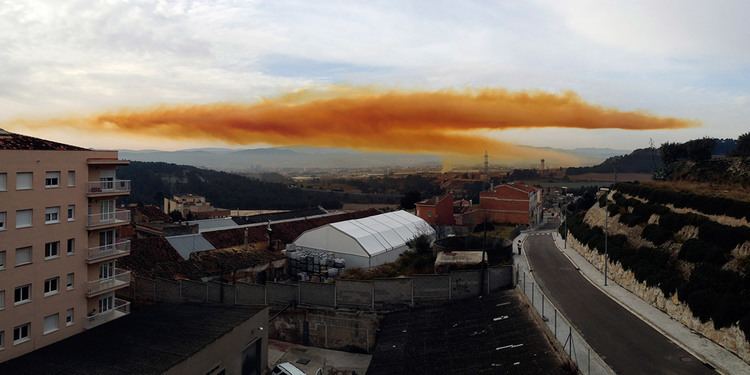Elevation 313 m (1,027 ft) Website igualada.cat Population 38,751 (2014) | Postal code 08700 Local time Friday 6:11 PM | |
 | ||
Weather 21°C, Wind S at 11 km/h, 55% Humidity | ||
Igualada ([iɣwəˈɫaðə]) is a municipality of the province of Barcelona in Spain. It is located on the left bank of the Anoia river, and at the western end of the Igualada-Martorell-Barcelona railway. Igualada is the capital and central market of the Anoia comarca, a rich agricultural and wine-producing district. The population, as of 2009, is 38,918.
Contents
- Map of Igualada Barcelona Spain
- Igualada Leather Museum
- Muleteers Museum Museu del Traginer
- Igualada Cemetery
- Church of Santa Maria
- Nursing home Asil del Sant Crist
- Economy
- Transportation
- Sports
- Twin towns Sister cities
- References
Map of Igualada, Barcelona, Spain
The city consists of an old town, originated in the 11th century, with narrow and irregular streets, including the remains of a fortress and ramparts, plus a new surrounding town with regular and spacious streets and many fine houses.
The city is 65 kilometres (40 miles) west from Barcelona and 20 kilometres (12 miles) west from the famous mountain and monastery of Montserrat.
Igualada hosts the European Balloon Festival, the largest hot air balloon festival in Spain and one of the largest in Europe. It takes place every year, since 1997, at the beginning of July. The city also hosts the Aerosport airshow which takes place every year in April or May.
Igualada Leather Museum
The Igualada Leather Museum (Museu de la Pell d'Igualada) was created in 1954 and was the first leather museum in Spain, and the third in Europe. The collections are displayed in two nearby buildings in Igualada: the "Cal Boyer" building, a former cotton textile factory from the late 19th century, and the "Cal Granotes" building, an 18th-century tannery.
"Cal Granotes" displays two floors of a typical tannery: the ground floor, where the leather preparation and tanning was done, and the upper floor, where the leather was dried hanging from bars.
In the early 18th century, the tanning workers from Igualada decided to leave the enclosure of the medieval walls and established new industries along a water pipe or irrigation ditch named "El Rec", already mentioned in 12th century documents and previously used by mills. The ditch has a length of 3049 meters and collects the Anoia river water from a lock.
Muleteer's Museum (Museu del Traginer)
The "Igualada Muleteer's Museum - Antoni Ros Collection" explains the evolution of transport using animals such as mules, horses, oxen, and the different relationships that paved the way for the profession of muleteer. It is distributed into three main thematic areas: professions, saddles and bridles, and carriages.
Igualada Cemetery
The new Igualada Cemetery was designed by the architects Enric Miralles and Carme Pinós after winning an architectural competition in 1984. Constructed between 1985 and 1994 as a replacement for the old "Cemetery Vell", it has become widely regarded as one of the most poetic works of the 20th century Catalan architecture. Enric Miralles, who died in year 2000 is buried in one of the tombs.
Church of Santa Maria
The Basilica of Santa Maria is the most important historical building of Igualada. The first settlement of Igualada is dated around year 1000, in the location were the current church lies today, which was at that time a crossing of 2 routes which were linking Barcelona with Aragon, and north of Catalonia with its south. Santa Maria church origin is from the 11th century, but the current building is mainly from the 17th century. During the Spanish Civil War it was converted into a market, and was restored after the war, under the guidance of the architect Cèsar Martinell. In 1949 Santa Maria obtained the title of Minor Basilica granted by the pope Pius XII.
Nursing home "Asil del Sant Crist"
The asil del Sant Crist is one of the most special buildings in Igualada and serves as a nursing home of elder people. Construction started in year 1931 thanks to a donation from Magdalena, Dolors and Concepció Castells and finished in 1941 after the Spanish Civil War. It was designed by Joan Rubió i Bellver, pupil of Antoni Gaudí, in late modernisme style, mixed with influences from the traditional Catalan architecture.
Economy
The local industries, mainly developed since 1880, include the manufacture of cotton, linen, wool, ribbons, cloth, chocolate, soap, brandies, leather, cards and nails.
Igualada has a long tradition of tanning and textile industries. The competition from low cost countries which produce inexpensive textile products and the stricter environmental laws applied on tanneries have had a serious impact in the local economy. Despite that, there are several well-known textile companies that keep their headquarters in Igualada, including Buff, Sita Murt and Punto Blanco.
Igualada is also home to Ultramagic, the only manufacturer of hot air balloons in Spain.
Transportation
Igualada's railway station is the terminus of a line connecting with Plaça d'Espanya in Barcelona. The A-2 motorway between Madrid and Barcelona bypasses the town.
Sports
Twin towns – Sister cities
Igualada is twinned with:
